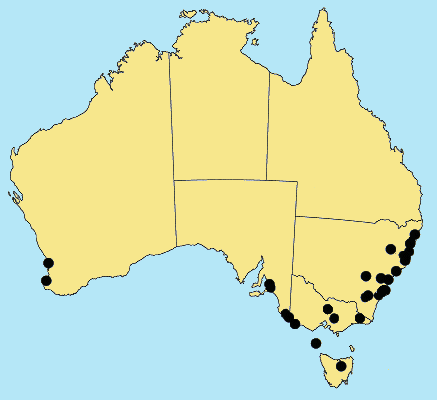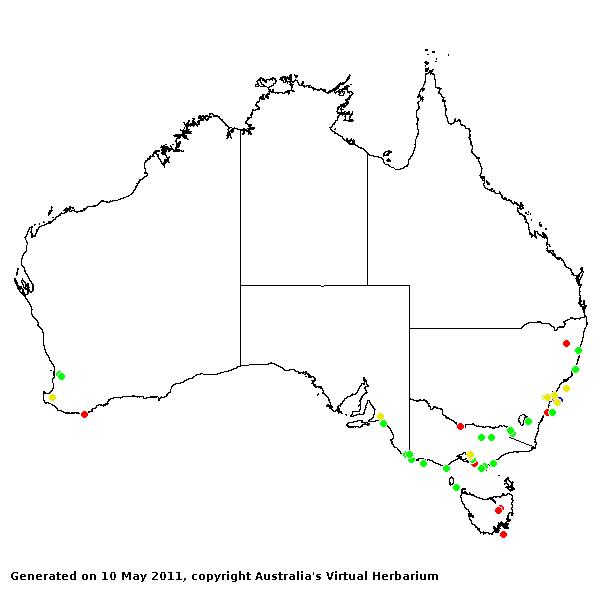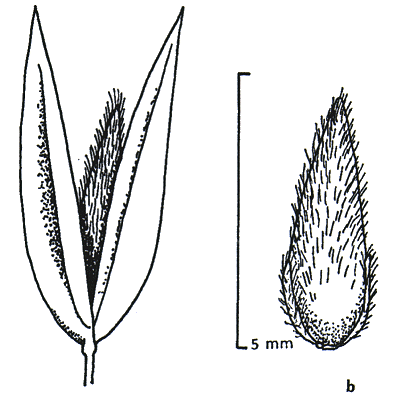Phalaris arundinacea* L. Sp. Pl. 55 (1753).
Classification. (GPWG 2001) : Subfamily Pooideae. Tribe Poeae.
Type of Basionym or
Protologue Information: LT: arundinacea 3, (LINN-78.7). LT (as
holotype) ineffectively designated by Anderson, Iowa St. Coll. J. Sci. 36:
37 (1961); effectively designated by Baldini & Jarvis, Taxon 40: 47?
(1991).
Key references
(books and floras): [1952] C.A.Gardner, Flora of Western Australia 1
Gramineae (26), [2002] D.Sharp & B.K.Simon, AusGrass, Grasses of
Australia, [2002] J.Wheeler, N.Marchant & M.Lewington, Flora of the
South West (428), [2006] J.Jessop, G.R.M.Dashorst, F.M.James, Grasses of
South Australia (239), [2008] S.W.L.Jacobs, R.D.B.Walley &
D.J.B.Wheeler, Grasses of New South Wales (338), [2009] A.Wilson (ed.). Flora
of Australia, Vol 44A. Poaceae 2 (146, 147 as var. arundinacea,
var. picta).
Illustrations:
[1952] C.A.Gardner, Flora of Western Australia 1 Gramineae (24
& 25, Pl. 4 & 5), [2006] J.Jessop, G.R.M.Dashorst, F.M.James, Grasses
of South Australia (241, fig. 183 as
var. arundinacea & 241, fig. 184 as var. picta), [2008]
S.W.L.Jacobs, R.D.B.Whalley & D.J.B.Wheeler, Grasses of New South Wales,
4th edn (338), [2009]. A.Wilson (ed.), Flora of Australia 44A: Poaceae
2 (148, Fig.22).
Habit. Annual
or perennial. Rhizomes present, elongated. Culms erect, 50–188 cm tall, 6–9
-noded. Leaves cauline. Ligule an eciliate membrane, 6–10 mm long, entire or
erose. Leaf-blades 10–44 cm long, 5–17 mm wide.
Inflorescence.
Inflorescence solid, a panicle. Panicle linear or oblong, dense, 7–40 cm long,
1–4 cm wide.
Spikelets.
Spikelets pedicelled. Basal sterile spikelets absent. Fertile spikelets 1 or
more flowered, with 1 fertile floret, comprising 2 basal sterile florets,
comprising 1(–2) fertile floret(s), without rachilla extension, ovate,
laterally compressed, 3.5–7.5 mm long.
Glumes. Glumes
similar, thinner than fertile lemma. Lower glume elliptic, chartaceous, keeled,
1-keeled, wingless or winged on keel, winged narrowly, 3 -nerved. Upper glume
elliptic, 3.5–7.5 mm long, chartaceous, keeled, 1-keeled, wingless or winged on
keel, 3 -nerved. Upper glume surface asperulous. Florets. Basal sterile
florets 2 or more, barren, without significant palea. Lemma of lower sterile
floret 30–40 % of length of spikelet, membranous, without keels. Lemma of upper
sterile floret 1.2–1.4 mm long.
Fertile lemma 2.7–4.5
mm long, keeled, 5 -nerved. Lemma surface indumented. Palea 2 -nerved, without
keels. Lodicules present. Anthers 3.
Continental
Distribution: Europe, Africa, Temperate Asia, Tropical Asia, Australasia,
North America, and South America.
Australian
Distribution: Western Australia, New South Wales, Victoria, Tasmania.
Western Australia:
Drummond. New South Wales: North Coast, Central Coast, South Coast,
Northern Tablelands, Central Tablelands, Southern Tablelands. Victoria:
East Gippsland, Eastern Highlands, Gippsland Plain, Midlands, Wannon. Tasmania:
King Island, Midlands.
Notes.
Vickery (1975) notes that the species is somewhat useful for pasture in marshy
soils, but is not widely cultivated in Australia.
Highly variable species, distinct from other
species of the genus.
1(0). Leaves green, with a pale midrib, not
striped 1a. var. arundinacea
Leaves striped green and cream 1b. var. picta.
Introduced. Southern
Australia, all states except N.T. and Qld. Native to temperate regions
throughtout the Northern Hemisphere, now widely distributed, occurring in New
Zealand, southern Africa, the Mediterranean, eastern Asia, the Pacific, North
and South America. Often in wet situations, in marshes or beside water. Flowers
Dec.-Feb.?.




